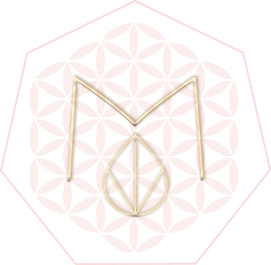by Marcela M. | Dec 3, 2012 | Blog, Christmas and NYE, cookies, Cooking basics and tutorials, Holidays, Recipe Box, Recipes, Sweets

Good morning friends! I hope you had a lovely weekend!
Today’s post participates in Whole Kitchen’s 2012 Advent calendar . A few days ago, Silvia contacted me to offer me to participate in it and I, of course, accepted! So today, get your aprons ready because we start baking! (Amigos hispanoparlantes, el texto en español está al final del post!)
I thought it was best to begin the holiday baking season with the basics: 3 simple cookie recipes and a few explanations on how to adapt they are adapted. I wanted to give you my staple recipes, the ones that are simple enough to make in whim, yet delicious, reliable and versatile to allow multiple modifications. In following posts, I will show you a few ideas for combining and decorating them, with varying degrees of difficulty, so that you can make a box of assorted cookies without spending days in the kitchen.
Let’s get started!
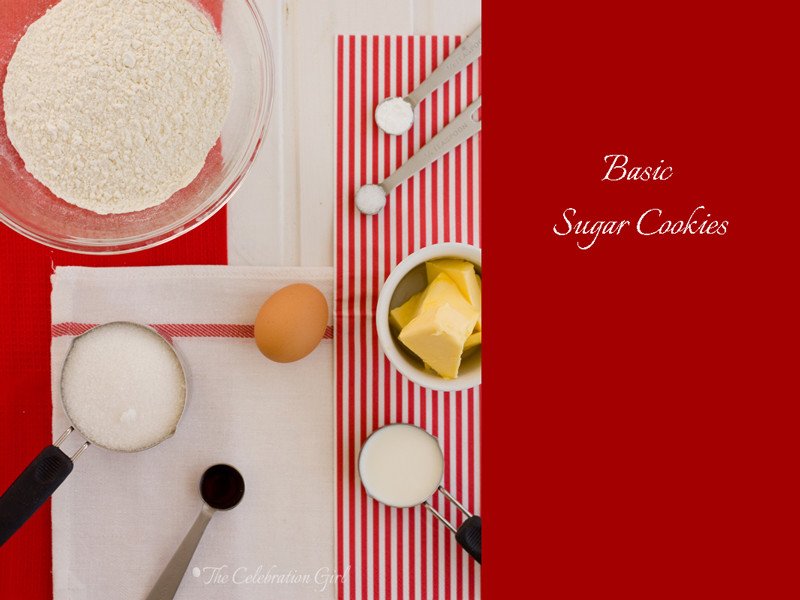
The first recipe is for the all time classic Sugar Cookie. The first time I made them was just a few years ago, inspired by some of my favorite bloggers and following to the letter the recipe for Martha Stewart’s Ideal Sugar Cookies. As time went by, I introduced a few little modifications: I normally double the amount of vanilla and, if baking with my children, who love to spread flour everywhere, I add more milk than usual to prevent the cookies from becoming too hard once baked. Also, since my son doesn’t tolerate dairy products too well, I frequently use margarine instead of butter, and vegetable milk instead of cow’s milk. The texture is different when baking with margarine, but the recipes turn out delicious nonetheless. One important note, though, is that margarine should not be beaten extensively or the final product becomes oily (and we don’t want that!). So, if that’s what you are using, cream it with sugar for a maximum of 3 minutes.
Take this as your basic recipe, and then start playing with it. You could use it as a basis for making sugar orange or lemon cookies, for example, by simply adding a teaspoon of orange or lemon zest and replacing the milk for lemon or orange juice, or you could make coffee flavored cookies by replacing 1 teaspoon of the milk for espresso. The possibilities are really endless. Just make sure that you maintain the balance between liquid and dry ingredients and that your replacements respect the original ratios.
Here’s the basic recipe (adapted from Martha Stewart):
Ingredients: 2 cups all purpose flour, 1/4 tsp salt, 1/2 tsp baking powder, 113 grs butter (1/2 cup) or margarine , 1 cup sugar, 1 beaten egg, 4 tbp milk or 1/4 cup milk ( this is the amount I use when I bake with my children because I know they will add too much flour when rolling and cutting. Please note that Martha’s original recipe calls for 2 tablespoons only), 1 teaspoon vanilla extract.
Preparation: 1) Pre heat the oven to 175 C. 2)Cream butter and sugar until the butter becomes almost white. Note that if you are using margarine, you should cream it for a maximum of 3 minutes 2) Add milk, vanilla and the beaten egg. Incorporate. 3) Whisk or sift together the dry ingredients: flour, salt and baking powder and add them to the batter, making sure not to overmix. 4) Extend plastic wrap on the kitchen’s counter, pour the dough in it, wrap it and refrigerate for a couple of hours. If you are baking this cookies in the summer and you live in very hot climates, I recommend putting it in the freezer for 1 hour instead. 5) When you are ready to bake the cookies, flour the kitchen counter, and roll using a rolling pin, considering that thicker cookies are moister and chewier, and thinner cookies are crispier. Cut the cookies using a cookie cutter or a knife, place on a baking sheet covered in baking paper and refrigerate. Do not skip the refrigerating step or your cookies will lose shape in the oven! I normally place them in the freezer for 20 minutes before baking. 6) Bake for 10-15 minutes. Do not let them brown.Let cool on a wire rack and eat or decorate.

Now let’s say you want to make chocolate sugar cookies instead, how do you adapt the basic recipe? It’s also very simple. As you can see from the pictures above, most ingredients remain the same, and a few new ones are added, namely cocoa, brown sugar and an extra egg to make up for the added dryness. Remember, it is a matter of ratios and balance between the different ingredients. Cocoa is a dry ingredient, so it counts as if we had increased the amount of flour. Brown Sugar gives the recipe a darker color, a stronger flavour (because it contains molasses) and, as sugar in general, acts as a binding agent. Having added these two ingredients, the recipe would be too dry if you didn’t add an extra egg, but if you prefer to keep the quantities intact and you don’t want to add an extra egg, you could do so by reducing 20% of the flour and replacing it by cocoa, and replacing 1/3 of the granulated sugar and replacing it with brown sugar. That is really all it takes.
Here’s the recipe (as I normally do it)
Ingredients: 2 cups flour, 1/2 cup cocoa, 1/2 tsp baking powder, 1/4 tsp salt, 113 grs butter or margarine, 1 cup granulated sugar, 1/3 cup brown sugar, 2 beaten eggs, 2 teaspoons milk, 1 teaspoon vanilla.
Preparation: 1) Pre heat the oven to 175 C. 2)Cream butter and the two sugars until light and fluffy. Note that, if you are using margarine, you should cream it for a maximum of 3 minutes 2) Add milk, vanilla and the beaten eggs. Incorporate. 3) Whisk or sift together the dry ingredients: flour, cocoa,salt and baking powder and add them to the batter, making sure not to overmix. 4) Extend plastic wrap on the kitchen’s counter, pour the dough in it, wrap it and refrigerate for a couple of hours. If you are baking this cookies in the summer and you live in very hot climates, I recommend putting it in the freezer for 1 hour instead. 5) When you are ready to bake the cookies, pour cocoa powder on the kitchen counter. I prefer to use cocoa instead of flour when making chocolate cookies because this prevents them from getting a white coat and accentuates the flavor 6) Roll using a rolling pin, considering that thicker cookies are moister and chewier, and thinner cookies are crispier. 7) Cut the cookies using a cookie cutter or a knife, place on a baking sheet covered in baking paper and refrigerate. Do not skip the refrigerating step or your cookies will lose shape in the oven! I normally place them in the freezer for 20 minutes before baking. 8) Bake for 10-15 minutes. Do not let them brown.Let cool on a wire rack and eat or decorate.

Today’s final recipe is another holiday classic, shortbread cookies, that I have adapted by including finely ground almonds in it. The main difference between sugar and shortbread cookies lies in the proportion between butter and sugar: Sugar cookies use double the amount of sugar than that of butter, and in shortbread cookies this ratio is reversed. Notice also that, in this recipe we also reduce 1/8 of the amount of dry ingredients (almonds count as dry ingredients and so does cornstarch) and that there’s a correlative reduction in the wet ingredients: instead of one egg, we use only an egg yolk and we omit the milk altogether. These cookies don’t require baking powder either, so they won’t rise. The result is a richer cookie, with a softer flavor, ideal for combining with fillings and chocolate.
As I mentioned before, I have modified this recipe by using almonds and almond extract, but you could omit them and use only flour, or replace these with other nuts (hazelnuts are also delicious).
Here’s my recipe for Almond shortbread cookies:
Ingredients: 1 cup flour, 1/2 cup finely ground almonds, 1/2 cup icing sugar, 1/4 cup cornstarch, 1/4 tsp salt, 113 grs butter, 1 egg yolk, 1/2 teaspoon vanilla, 1/2 teaspoon almond extract
Preparation: 1) Put the finely ground almonds, flour, cornstarch, salt and icing sugar in the food processor and pulse until combined. 2) Add the wet ingredients and pulse until the dough separates from the bowl 3) Remove the dough from the food processor and knead it on the counter. 4) Cover in plastic wrap and refrigerate for two hours. 5) Pre heat the oven to 175 C. Remove the dough from the refrigerator, roll on a floured surface and cut in the desired shapes. Place the cookies on a baking sheet lined with baking paper and bake for 10-15 minutes. Let cool on a wire rack and eat or decorate.
Tomorrow I’ll start showing you some ways in which you can play with these recipes!
Now, please tell me: Do you bake cookies for the holidays? What are your favorite recipes? Do you like to decorate them and, if so, how do you do it?
Have a lovely Monday!
Con sabor latino…
Buenos días queridos amigos y bienvenidos sean todos aquellos nuevos lectores que llegan desde Whole Kitchen! Espero que hayan pasado un hermosísimo fin de semana.
El post de hoy participa en el Calendario de Adviento 2012 de Whole Kitchen . Hace unos días, Silvia me contactó para preguntarme si quería participar en el mismo y yo, por supuesto, acepté! Así que preparen sus delantales, porque hoy vamos a hornear!
Para inaugurar la temporada de cocina de la época navideña, pensé que sería mejor empezar por la base: 3 recetas simples y un par de explicaciones acerca de cómo introducir variaciones a las mismas. Quise compartir con ustedes aquellas recetas a las que vuelvo una y otra vez, aquellas que son lo suficientemente simples como para hacer en menos que canta un gallo, a la vez que confiables, deliciosas y versátiles como para permitir que cada uno deje volar su creatividad. En posts sucesivos voy a mostrarles ideas de cómo combinarlas y cómo decorarlas con distintos grados de dificultad, para que estas fiestas puedan tener una caja de galletitas variadas sin necesidad de pasar horas y horas en la cocina.
Comencemos!
La primera receta que quiero compartir con ustedes es la de las clásicas galletitas de azucar. La primera vez que la hice fue apenas unos años, y en esa ocasión y muchas otras, seguí al pie de la letra ESTA receta de la inigualable Martha Stewart. A medida que el tiempo pasó, fui introduciendo algunas modificaciones, por ejemplo suelo duplicar la cantidad de vainilla y, si preparo la receta con mis hijos, suelo duplicar la cantidad de leche porque tienden a agregar mucha harina cuando estiran la masa y me ha ocurrido que si sigo la receta al pie, quedan un poco duras. Tambien suelo hacerlas con margarina y leche vegetal porque mi hijo, sin llegar a ser alergico, nunca a tolerado muy bien que digamos los lacteos. Debo aclarar que la textura resultante es un poco diferente cuando uno trabaja con margarina, pero creanme que son deliciosas de todas maneras. Una advertencia importante, sin embargo, es que la margarina no debe batirse mucho tiempo con el azucar, como hacemos con la manteca, porque si no las galletas resultaran oleosas. Si usan este ingrediente, recuerden no batirla más de 3 minutos.
Les sugiero tomar esta receta como base y luego experimentar con otros sabores. Por ejemplo, si quieren hacer galletitas de limon o de naranja, pueden agregar una cucharadita de té de ralladura de limón o naranja, y reemplaza la leche por jugo de limón o naranja. Si quieren hacer galletitas de café, pueden reemplazar una cucharada de leche por una de café espresso…y así sucesivamente. Las posibilidades son enormes! Sólo tengan en cuenta que, para que la receta resulte bien, es necesario mantener el equilibrio entre los ingredientes secos y líquidos, y que los reemplazos mantengan las raciones originales.
Esta es la receta para las galletitas de azucar básica (adaptada de Martha Stewart)
Ingredientes:2 tazas de harina todo uso, 1/4 cucharadita de sal, 1/2 cucharadita de levadura química (Polvo de hornear Royal), 113 grs de manteca o margarina vegetal, 1 taza de azucar blanca, 1 huevo batido, 4 cucharadas o 1/4 taza de leche (puede ser vegetal. Tengan en cuenta que la receta original sólo requiere dos cucharadas y que yo sólo la duplico porque mis hijos tienden a agregar demasiada harina luego. Si no cocinan con niños o si sus niños son disciplinados al agregar harina, es mejor mantener la cantidad original), 1 cucharadita de vainilla.
Preparación: 1) Bata la manteca pomada con el azucar hasta que la preparación resulte en una crema blancuzca y esponjosa 2) Agregue leche, vainilla, y el huevo batido e incorpore 3) Mezcla con batidor de alambre o cierna los ingredientes secos: harina, sal y levadura química, y agreguelos en dos veces. Mezcle sólo hasta que todos los ingredientes estén incorporados. 4) Envuelva la masa en papel film y lleve al refrigerador por al menos dos horas. Si están haciendo esta receta en verano o en climas muy cálidos, yo prefiero poner la masa una hora en el freezer. Es más facil trabajarla luego! 5) Cuando quiera hornear las galletas, retire la masa del freezer y estirela con palote sobre una superficie lisa. Tenga en cuenta que si la estira levemente gruesa las galletitas resultaran mas humedas, y si la estira finita, resultaran crocantes. 6) Corte las galletitas usando un cortante especial o cuchillo, colóquelas sobre una placa para horno cubierta con papel de hornear y refrigere. Es muy importante que no omita este paso! Si las galletitas no son refrigeradas pierden la forma en el horno! Yo suelo colocar la placa en el freezer durante 20 minutos para obtener mejores resultados. 7) Hornee a 175 C durante 10/15 minutos. No deje que tomen color (eso las vuelve duras). Deje enfriar sobre una rejilla y coma o decore.
Ahora bien, digamos que queremos hacer galletitas de chocolate ¿cómo transformamos la receta original? Es de verdad muy sencillo. Como pueden ver si comparan las dos primeras fotos, la mayor parte de los ingredientes se mantienen constantes y sólo se agregan tres: cacao, azucar morena, y un huevo más para compensar por las nuevas adiciones. Recuerden que modificar recetas es una cuestión de mantener proporciones y equilibrio entre los diferentes ingredientes. Como el cacao es un ingrediente seco, su adición cuenta como si hubieramos agregado harina. El azucar moreno cambia el sabor de la receta (porque contiene melaza), contribuye a que las galletitas tengan un color más oscuro y, como todo azucar en general, ayuda a que los ingredientes “liguen”. Habiendo agregado estos ingredientes, es necesario entonces sumar un huevo más para que la masa no resulte seca. Ahora bien, si prefieren usar uno solo (cuantas veces nos hemos encontrado con un solo huevo en la cocina, verdad? Yo,muchas!), modifiquen las cantidades de harina y de azucar blanca: reduzcan 20% la cantidad de harina y reemplacenla por cacao, y reduzcan 1/3 de la cantida de azucar blanca y reemplacenla por azucar moreno. Es tan sencillo como eso!
Esta es mi receta para galletitas de chocolate
Ingredientes:2 tazas de harina todo uso, 1/2 taza de cacao amargo, 1/4 cucharadita de sal, 1/2 cucharadita de levadura química (Polvo de hornear Royal), 113 grs de manteca o margarina vegetal, 1 taza de azucar blanca, 1/3 taza de azucar morena, 2 huevos batidos, 2 cucharadas de leche (puede ser vegetal), 1 cucharadita de vainilla.
Preparación: 1) Bata la manteca pomada con los dos azucares hasta que la preparación resulte esponjosa. Recuerden no batir más de 3 minutos si usan margarina 2) Agregue leche, vainilla, y los huevos batidos e incorpore 3) Mezcla con batidor de alambre o cierna los ingredientes secos: harina, cacao, sal y levadura química, y agreguelos en dos veces. Mezcle sólo hasta que todos los ingredientes estén incorporados. 4) Envuelva la masa en papel film y llevela al refrigerador por al menos dos horas. Si están haciendo esta receta en verano o en climas muy cálidos, yo prefiero poner la masa una hora en el freezer. Es más facil trabajarla luego! 5) Cuando quiera hornear las galletas, retire la masa del freezer y estirela con palote sobre una superficie lisa. Tenga en cuenta que si la estira levemente gruesa las galletitas resultaran mas humedas, y si la estira finita, resultaran crocantes. 6) Corte las galletitas usando un cortante especial o cuchillo, colóquelas sobre una placa para horno cubierta con papel de hornear y refrigere. Es muy importante que no omita este paso! Si las galletitas no son refrigeradas pierden la forma en el horno! Yo suelo colocar la placa en el freezer durante 20 minutos para obtener mejores resultados. 7) Hornee a 175 C durante 10/15 minutos. No deje que tomen color (eso las vuelve duras). Deje enfriar sobre una rejilla y coma o decore.
La última receta que les traigo hoy es la de otro clásico de está epoca: las galletitas de manteca o shortbread cookies, la que yo he modificado para transformarla en galletitas mantecosas de almendras. La diferencia principal entre las galletitas de azucar y las de manteca radica en la proporción entre estos dos ingredientes: las galletitas de azucar usan el doble de azucar que de manteca, y en las de galletitas de manteca esta proporción se invierte. Noten tambien que en estas galletitas reducimos 1/8 la cantidad de ingredientes secos, y teniendo en cuenta todo lo anterior (menos ingredientes secos y menos azucar), debemos reducir tambien los ingredientes líquidos, por lo que en lugar de un huevo entero usaremos sólo una yema, y omitiremos la leche. Las galletitas resultantes son más densas y de un sabor más neutro, no tan dulces,por lo que son ideales para combinar con rellenos y chocolate.
Como mencioné antes, yo he modificado la receta incluyendo almendras molidas en la misma. Si prefieren no hacerlo, pueden reemplazar la cantidad de las mismas por harina común (todo uso), bien pueden experimentar con otras nueces (yo las hecho tambien con avellanas molidas y quedan muy bien, por ejemplo).
Aquí está mi receta para galletas de almendras y manteca:
Ingredientes: 1 taza de harina, 1/2 taza de almendras molidas bien finitas, 1/4 taza de almidon de maiz (maizena), 1/2 taza de azucar impalpable, 1/4 cucharadita de sal, 113 grs de manteca, 1 yema de huevo, 1/2 cucharadita de extracto de vainilla, 1/4 cucharadita de extracto de almendras.
Preparación: 1) Coloque almendras, harina, sal, azucar y almidón de maiz en el bowl de la procesadora y pulse hasta que estén bien combinados. 2) Agregue todos los ingredientes húmedos (manteca, huevo y extractos) y pulse hasta que la masa se separe de las paredes del bowl. 3) Retire la masa de la procesadora y trabajela sobre la mesada hasta formar un bollo. 4) Envuelva la masa en papel film y lleve al refrigerador por dos horas. 5) Espolvoree harina sobre una superficie lisa, y estire la masa con palote. Corte de la forma deseada, coloque en una placa para horno cubierta con papel de hornear y hornee a 175 C por 10-15 minutos. No deje que tomen color. Deje enfriar sobre una rejilla y coma o decore.
Mañana comenzaré a mostrarles algunas formas en que pueden jugar con estas recetas.
Ahora cuentenme: ¿hornean galletitas para las fiestas? ¿cuales son sus recetas favoritas? ¿suelen decorarlas y de qué manera?
Que tengan un hermoso día lunes!
by Marcela M. | Sep 5, 2011 | Blog, Cakes, Cooking basics and tutorials, Recipe Box, Recipes, Sweets, Uncategorized

Good morning friends! I hope you had a great weekend and that you are ready to start a new week.
As I promised in my last post, here is the tutorial for making fondant flowers like the ones with which I decorated my daughter’s 3rd birthday cake. You will see that they are very easy to make, and that you can do so with tools that you most probably already have at home. I have included step-by-step pictures to make it easier to follow the instructions, but if you have any doubts, please do not hesitate to contact me!
So, let’s begin! Here is what you will need:

1- Fondant in whatever colour/colours you want your flower to be. I used only white, but you may combine different ones, according to the colours of your cake/what you have available.
2- Flower cut-outs of 3 different sizes. I used cutters from 2 different sets: the bigger one is from this Wilton cookie cutter set, and the two smaller ones from this set, also by Wilton.
3- Rolling pin (the one in the picture was given to me by my grandmother, as a present, when I was 8 years old)
4- A paper straw. You can also use a lollipop stick. Or the back of a brush. Whatever you have on hand!
5- Icing sugar, so that the fondant doesn’t stick to the table. When the weather is too hot, I use a combination of icing sugar and cornstarch.
6- Non-pareils (I used multi-coloured ones)
7- A small bowl, for putting the non-pareils in it.
8- A glass/ an egg tray (from your fridge), depending on the size of your flowers, to shape them (I will show you how to do this)
9- Aluminium foil
10- Sugar syrup/sugar glue, and a small brush (not in the picture). To make sugar syrup, put sugar in a small pan, cover with water and bring to the boil until it thickens (about 5 minutes). This will help glue the different parts of the flower together, but I must warn you that it works only when fondant is not dry yet. Once the flowers are dry, use royal icing to attach them to the cake.
Instructions:
1- The first thing you will need to do, is to prepare the flower drying trays (which are the place where your flowers will dry, so that they will look like real flowers and not be flat). In order to do so, cut a rectangle of aluminium foil and, using your hands, place it on top of a cup. Once it is attached to the sides of the cup, lift it a little bit, very carefully, and curve the top by pressing in the middle with your fingers. It should look as in the picture on the right:
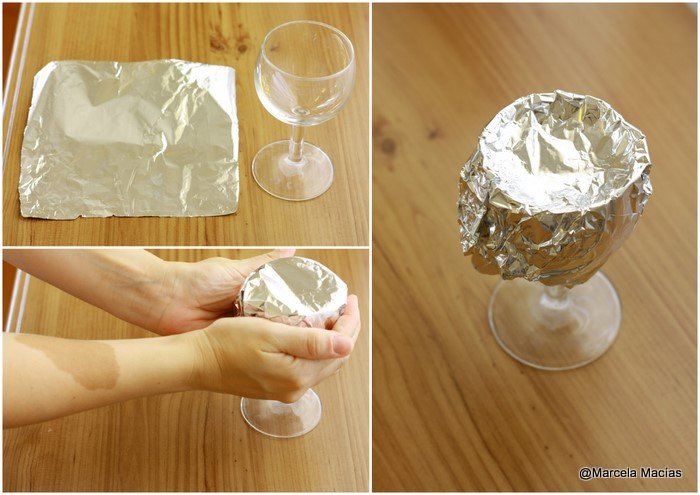
2- If you need to make several small flowers or blossoms, you may use an egg tray from your fridge. Cut aluminium foil to cover the tray (or as many holes as flowers you are planning to make) and, using the same method above, work it until you have the drying tray ready, as in the pictures below:
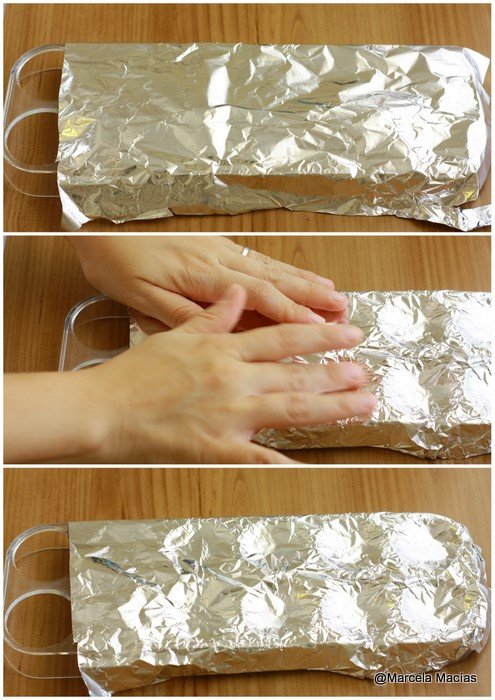
3- Now that your former/drying cup and tray are ready, it is time to make the flowers! Begin by kneading a little bit of fondant. Put some icing sugar on the table, and extend the fondant using a rolling pin. Roll it as thin as possible, so that the flower petals look more realistic.
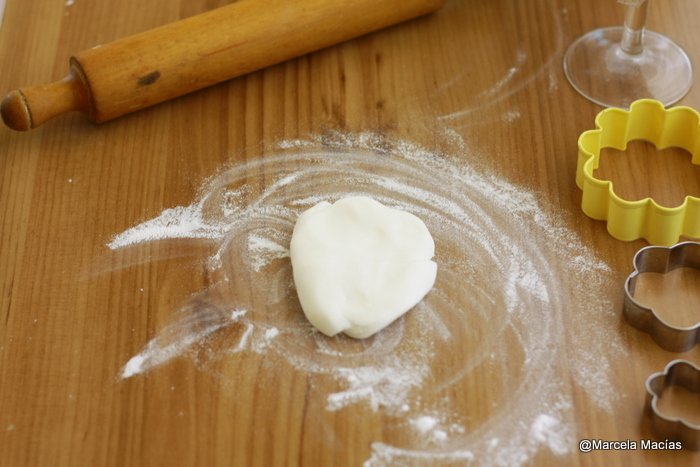
4- Cut the flowers in three different sizes. You will need one of each per flower.
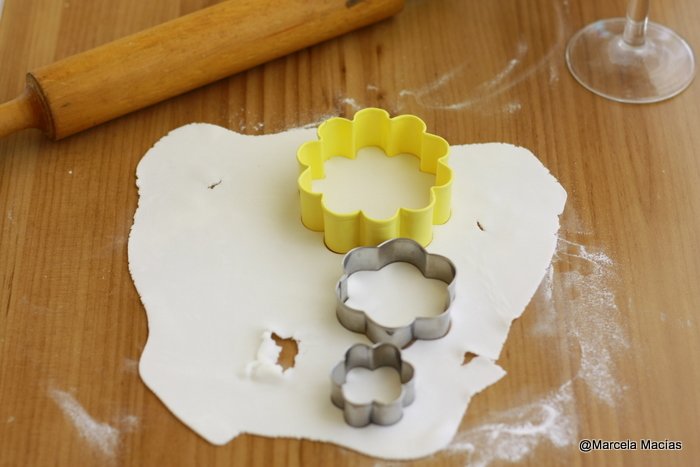
5- Start by working on the biggest size. Leave the other two aside, and put the remaining fondant in a plastic bag so that it will not dry out.
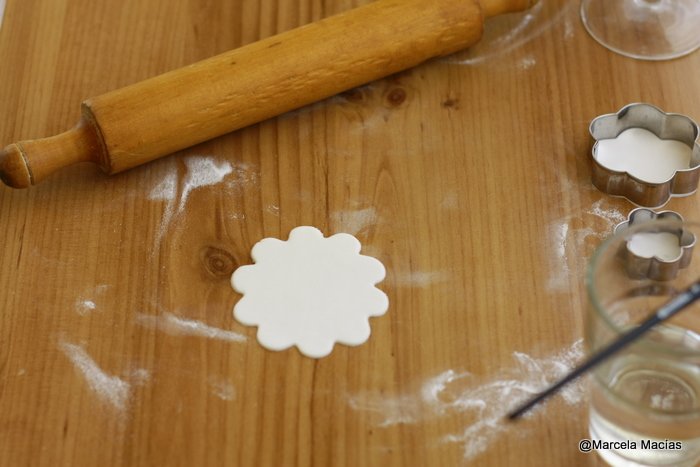
6- Take the flower with your hands and, slowly and gently, press the petals with your thumbs, so as to make them thinner (If you have one, you may use a ball tool to do this instead)

This is how the flower will look when you are done. It is very important that you do it slowly or the petals may break!
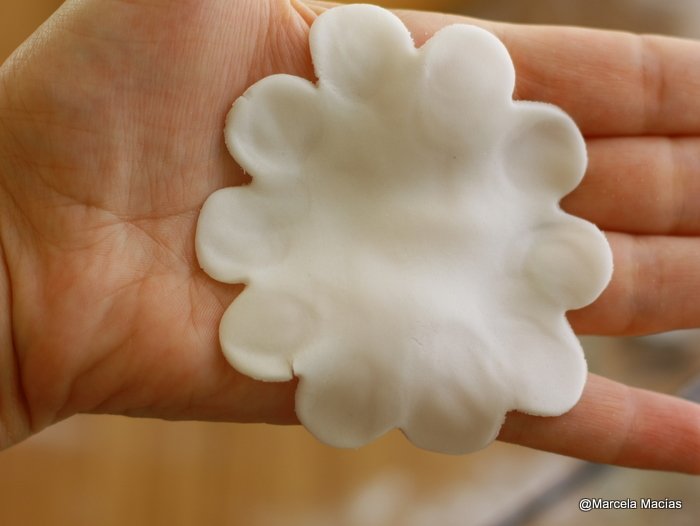
7- Gently (VERY gently) roll a paper straw, a lollipop stick or the back of your brush, on each petal. This will give the petals some shape.
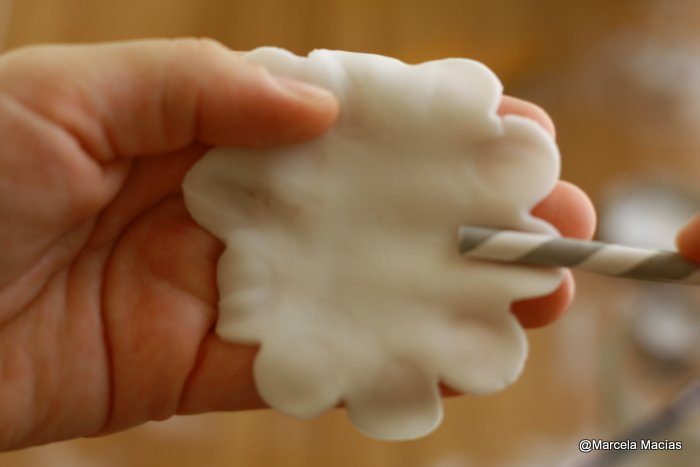
8- Place the petal in the drying cup, on top of the foil. Don’t worry, it won’t stick to it and, once it is dry (about 24 hours), you will be able to remove it easily.
9- Using the same method, shape the middle- sized flower.
10- Put a drop of sugar syrup in the center of the big flower and add the middle- sized flower to it. Make sure the petals of the smaller flower are placed between the petals of the bigger one. Press softly in the center for the petals to pop up.
11- Using the same method, shape the smallest flower.
12- Put a drop of sugar syrup in the centre of the middle-sized flower and add the smallest flower to it, as you did before. Press softly in the centre for the petals to pop up.
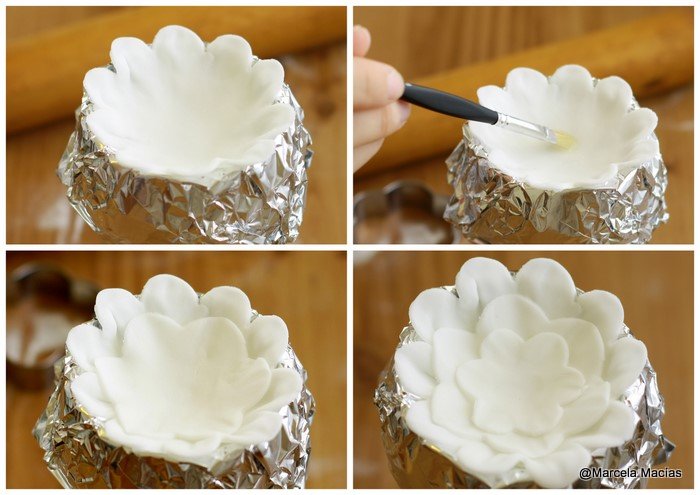
13- Now it is time to make the stigma (the centre of the flower). You will need a small ball of fondant, sugar syrup and non-pareils.
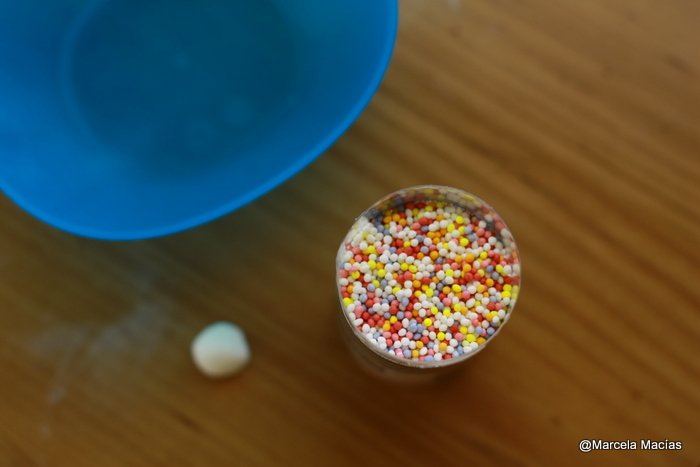
14- Make a small ball of fondant.
15- Brush it with sugar syrup
16- Put a few non-pareils in a small bowl. Place the fondant ball inside and roll it all over, until it getscompletely covered in non-pareils.

17- Put a drop of sugar syrup in the centre of the drying flower and place the stigma on top of it. Press softly so that it adheres to the flower.

18- Repeat the process to make as many flowers as you need in your decoration.
19 – Let dry for 24 hours, remove slowly from the drying cup and attach with royal icing to your cake.

Very easy, isn’t it? I know how hard it can be to find gum-paste/fondant modelling tools in some countries, and how expensive these can be too, so I wanted to show you how you can get around buying them and still get some pretty flowers. I hope I achieved my goal!
May you have a wonderful week!
by Marcela M. | Jul 12, 2011 | Blog, Cooking basics and tutorials, Marmalades and jams, Recipe Box, Recipes, South America, Sweets, Travel, Uncategorized
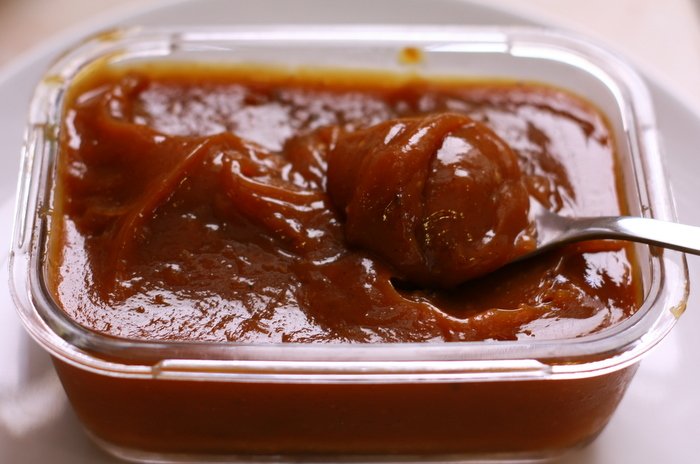
Happy Tuesday dear Friends! I hope you had a wonderful start of the week.
In this past post I talked to you about dulce de leche, and I mentioned that this milk jam is the traditional filling for cornstarch cookies or alfajores de maizena. After the post, a few friends asked me how they could make dulce de leche, because they don’t live in countries where one can simply go and buy one jar at the supermarket.
So here I am, showing you three easy ways of making your own, the Argentinian way. Why the Argentinian way? Because you can find different versions of the same product pretty much all around Latin America, but if you read the components you will notice slight differences in the ingredients. For example, while in Argentina dulce de leche is made 100% with cow’s milk, traditional mexican dulce de cajeta is made with goat’s milk; and in Uruguay it generally includes cornstarch (which makes it thicker). It is also possible to find it outside of Latin America, for example in France (where it is called confiture de lait), in Israel (ribat jalav) and, I am told, even in India.
So how can one make dulce de leche, when it is not readily available for purchase?
There are three ways I know of, but only two of which I have tried:
I- By submerging a can of sweetened condensed milk in a pan full of water, and letting it boil for about 3 hours (in a normal pan) or 45 minutes (in a pressure cooker). If you use this method, you should remember that:
a) The can has to be completely covered in water at all times, otherwise any part that remains uncovered will not mutate into dulce de leche (as in the picture below)

b) Once the 3 hours have passed, make sure that the can is COMPLETELY cooled before opening it. If you open it when it’s still hot, the content will burst and there is a serious risk that you may burn yourself. So wait. Put in the fridge for faster cooling if necessary. But do not open it immediately!
This is what will be waiting for you when you open the can:
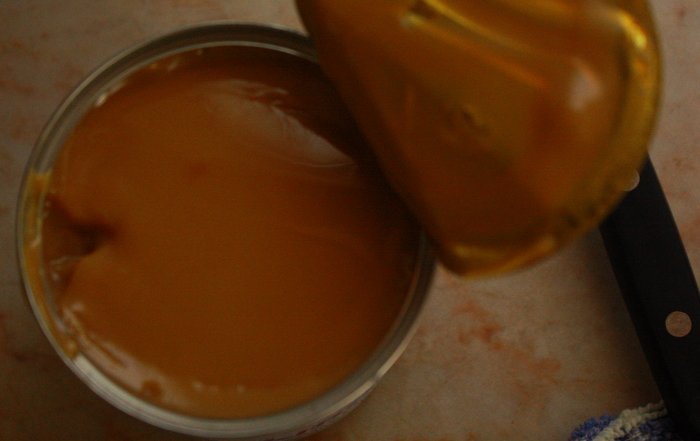
II- If the possibility of burning yourself scares you a lot, you can try Chef David Lebovitz’s method, which consists of baking sweetened condensed milk au bain marie, covered in aluminum foil. I haven’t tried it, but it does look like a safer option, and it takes less time than the original can version.
III- Make dulce de leche from scratch. It is not difficult to do so, and, though it is a bit time consuming because you need to watch it carefully, it is worth it. I must admit that, when I lived in Argentina, I didn’t do it very often, because there are so many good brands available that I didn’t see the point. But one day, when I was 21 years old, my father (who loved to cook) suggested that we tried, so we asked around for a recipe and we made our first batch of dulce de leche. This is the recipe I will share with you today.
To make 1 kilo of dulce de leche, you will need
– 5 litres of milk
– 1 kilo of sugar
– 1 vanilla pod (if you don’t have vanilla pods, you can use 1 tablespoon of vanilla extract)
– 1 tablespoon of bicarbonate of soda
– 1 big pan
– 1 wooden spoon
The preparation is very simple.
1- Put the milk in the pan. Make sure the size of the pan is twice as big as the amount of milk, because the preparation will rise once you add the bicarbonate of soda and, if it is too small, you run the risk of it overflowing the pan and making a big mess. In order to prevent this, I am told that one should put in the pan a few small glass balls (like the ones children play with), because this will prevent the preparation from rising too much.
2- Add sugar, all at once.

3- Stir the preparation and bring to the boil. Let it boil for 5 minutes, stirring constantly

4- Bring heat to the minimum, and add the vanilla pod and the bicarbonate of soda (I added 1 teaspoon because I was making half the preparation only)

5- Let the preparation boil at minimum heat, stirring every 10-15 minutes. It should look as in the picture below:

6- After about 1 hour, the milk will start to brown, and will look like this:

7-After another hour, it will become even darker, like this:

8- After around 1/2 hour, it will be thicker and darker and it will have considerably reduced. When it reaches this point, start stirring constantly for about 15 minutes.
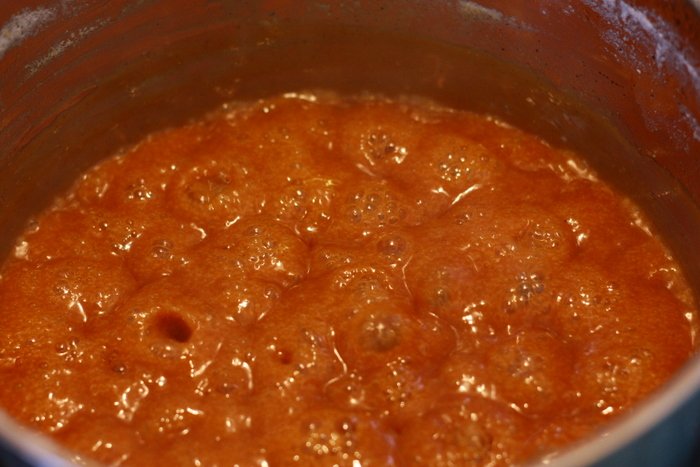
This is the consistency it had at that point. It doesn’t look like it’s ready but, trust me, it almost is.

9- After 15 minutes, turn off the heat and continue stirring for another 5-10 minutes. What I like to do then is to transfer it to another pan (it cools faster). This is how it looked right after I transferred it:

As you can see, it still looks quite liquid, like a caramel sauce.

But all it needs is to cool down completely to reach the appropriate consistency.

10-Once it has cooled down, transfer it to a glass container and keep it in the fridge. This is how it will look after 3 hours in it:

Ready to eat and to add to preparations such as cookies, cakes, brownies, ice-creams, puddings, and so many more!
I hope that you will like it if you decide to make it.
Have a wonderful week!
If you want to know how to make dulce de leche repostero (baking dulce de leche), check this post
by Marcela M. | Jul 8, 2011 | Blog, Cooking basics and tutorials, cupcakes, Recipe Box, Sweets, Uncategorized

Good morning everyone! I hope you are having a lovely day.
Today’s post was inspired by the blogosphere. For the past several months, I have noticed a profusion of super cute owl parties (such as this one, this one and this one) and owl related products (such as these and these printables, these cake-pops and these t-shirts). All these were such a joy to look at that I felt compelled to create something owly too. Who wouldn’t want owls after looking at all those beauties, right?
So yesterday, I did. I had three cupcakes in the freezer, unfrosted, and a few bits and pieces of fondant left from other projects, so I decided to create a few Owl fondant cupcake toppers. I looked at some owl drawings and tried to de-construct their different shapes. Then I took the fondant I had and this is what I came up with.
I- The Yellow and Orange owl, inspired by this adorable birthday t-shirt by Modern Frills.
In order to make it, you will need the following materials:

1- Fondant in three different colors. I tried to stick to the original color palette as much as possible, so I used yellow, brown and red. I also used white fondant for covering the cupcake, and attached to it the topper itself.
2- 1 round cookie/fondant cutter (I used one from a set I got from Ikea, but any would do. In the past I have even used caps from coca-cola bottles!)
3- 1 small star-shaped cookie/fondant cutter
4- Round Piping tips number 10 and 12
5- Royal icing (I used one in a tube because there was no point in making a whole batch from scratch for just 1 cupcake topper)
Procedure:
1- For making the owl’s body, roll yellow fondant and cut one circle. Separate the circle from the rest of the fondant and then, very softly, roll the rolling pin on top of it just a couple of times, so that the circle becomes slightly wider at the sides.
2- For making the Owl’s wings, roll red fondant and cut two circles, using the back of the number 10 tip. Roll the rolling pin on top of them so that the circles become ovals. You could also use a leaf-shaped cutter for doing this.
3- For making the eyes, roll red fondant and cut two circles using the back of the number 10 tip (as for making the wings). Roll the brown fondant, and cut two circles using piping tip number 12 (the tip itself, not the back). Place a brown circle on top of each red circle.
4- For making the ears, roll yellow fondant and cut two triangles using the points of the star-shaped cutter. Trim of necessary.
5- For making the nose, roll brown fondant and cut 1 triangle with the star-shaped cutter (as for making the ears). Roll the rolling pin on top to make the triangle longer and trim the sides to achieve the desired shape.
All the parts should look like this before assembly:

In order to assemble the owl, simply place the yellow circle that forms the body on top of the white fondant circle . Glue it with water or sugar syrup (Argentinians friends: almibar). Attach the eyes, nose, ears and wings. Finally, place little dots of royal icing on the wings.
Here’s how it looked right after I finished it, before placing it on top of the cupcake:

II- The second owl was loosely based on this cute gift package designed by Delicious Tea. I started with every intention of doing that design, but then thought it would be funny to make a slightly angry owl, so I re-shaped its eyebrows and eyes 😉
In order to make this owl you will need the following materials:

1- Fondant in 4 different colours. I used red, yellow, brown and black.
2- 1 small square fondant/cookie cutter (mine comes from the same Ikea set I mentioned before)
3- 1 big piping tip. (It could be a D2 or M1. I used a petal shaped one because I had it handy, but since what you need is its back, any big one would do)
4- 1 medium size leaf-shaped cutter
5- 1 small heart-shaped cutter
6- 1 small star-shaped cutter
7- 1 pipint tip number 12
8- 1 scalloped square cutter (mine came with a Wilton set)
Procedure:
1- For making the body, roll red fondant and cut a square. Using the small scalloped square cutter, press softly with one side only to shape feathers. You can also draw the feathers with a food decorating coloring pen.
2- For making the eyes, a- roll yellow fondant and cut 2 circles using the back of the big piping tip, b- roll white fondant and cut 2 circles using the back of the number 12 tip, c- roll black fondant and cut 2 circles using the number 12 tip itself. Place one black circle on top of each white circle and then attach the latter to each yellow circle.
3- For making the eyebrows, roll brown fondant and cut a circle with the back of the number 12 tip. Cut the circle in half and, using the the same cutter trim the centre of each half to shape the eyebrows.
4- For making the wings, a- roll brown fondant and cut 2 leaves. Take 1 of them and proceed as with the eyebrows. This is the wing that will be attached to the left side. Take the remaining wing and trim the edges until it looks as in the picture. b- Roll the red fondant and cut a heart. Separate the heart from the remaining red fondant and, using the same cutter, cut again, removing the lower part. c- Roll yellow fondant and cut a heart out of it. Place the piece of red heart on top of the brown wing, then attach to its lower part the yellow heart (it will look as if there was a red heart below the yellow one)
5- For making the nose, cut a triangle using a point of the star-shaped cutter.
This is how all parts should look like before assembly:

To assemble this owl, simply place the eyes on the upper part of the body (about half the eyes should be inside the body, and half should be out). Attach the eyebrows and shape to give the owl’s look the desired expression. Attach wings and nose. It’s like working on a collage, very simple!
This is how it will look like, once finished:

III- The third owl, was inspired by this cute invitation by the Sugar Bee Bungalow.
In order to make this owl you will need:

1- Fondant in 5 different colours. I used blue, orange, brown, black and white.
2- 1 round-shaped cutter
3- 1 scalloped square cutter
4- 1 Number 12 piping tip
5- 1 star-shaped cutter
Procedure:
1- For making the body, roll brown fondant and cut a circle (with the medium size cutter). Detach the circle from the remaining fondant and roll the rolling pin on top of it, so that it achieves an oval shape (If you have an oval -shaped cutter, just use that one).
2- For making the belly and the wings, roll blue fondant and cut three circles using the back of the number 12 tip. As with the body, roll the rolling pin on top of them, so that they become ovals.
3- For making the eyes: a- roll white fondant and cut 2 circles using the back of the number 12 tip, b- roll black fondant and cut 2 circles using the number 12 tip itself, and c- Place a black circle on top of each white circle.
4- For making the ears, roll the brown fondant and cut 2 triangles using the points of the star-shaped cutter.
5- For making the nose, roll orange fondant and cut 1 triangle. Detach the triangle from the remaining fondant and roll the rolling pin on top of it,so as to make it longer. Trim if necessary.
6- For making the feet, roll orange fondant and cut 1 square using the scalloped square-shaped cutter. Cut the square in two using the same cutter, then divide one of those parts in half. Each half is 1 foot.
This is how all parts should look before assembly:

For assembling this owl: a attach the body to the white circle that will cover the cupcake, b- attach the belly to the body, c- attach the eyes to the body (they should be half on top of the blue belly, half over it, more or less), d- attach the wings, e- attach the ears, f- attach the feet. And that’s all!
Here is how this owl looked just after I finished making it. As you can see it is still shiny from the water I used for attaching the different parts. After a few hours the water dries out, don’t worry.

And here is another look at all three owls before putting them on top of the cupcakes.
For placing them on the cupcakes, I put apricot jam on the said cupcakes, lifted the toppers with a spatula, placed them each on top of a cupcake, and pressed very, very lightly on the sides so that they would attach properly to them.
As you can see, they are very easy to make!

I hope that you liked this tutorial! If you have any doubts about any of the explanations, let me know and I’ll try to guide you through the process the best I can. And if you make them, please share your pictures, I would love to see them!
Have a wonderful weekend, full of love and laughter!
by Marcela M. | Jun 29, 2011 | Blog, Cooking basics and tutorials, cupcakes, Recipe Box, Recipes, Sweets, Uncategorized

Hello there!
This blog is one month old today, so we’ll celebrate with a double post! In this one I’ll reveal the secret to my birthday’s flowery cupcakes and in the next one we’ll talk cake-pops.
The secret is…that there is no secret 😉 My flowery cupcakes were inspired by Glory Albin’s fabulous hydrangea cupcakes. I saw them in her blog, Glorious Treats, long ago, but the right occasion for making them never seemed to appear. Until my last birthday! And I will definitely be making them again.
My cupcakes were chocolate ones, as Glory’s, but I did not follow her recipe. I used, instead, one of the recipes that Bakerella shares in her book . This is a recipe my children LOVE, so if you have the book, I recommend it*. But if you don’t have the book, your favorite chocolate cupcake recipe will do. You could also try this one or this one (which Bakerella says adapts very well to cupcakes, without the frosting), which are delicious as well.
For the frosting, I used regular vegan buttercream, from the same batch I used for frosting my birthday cake.
How did I make those flowers? With the help of my trustworthy friend, Wilton’s 2D tip:

I divided the frosting in two, coloured each batch, put both colours side by side in the piping bag and then I simply piped the flowers. In order to see a VERY clear tutorial on how to do it, including pictures, check Glory’s blog here. Actually you should go visit her blog anyway because her confections, dessert tables and crafting ideas are truly amazing!
So there you have it: the secret to beautiful and easy hydrangea cupcakes!
I’ll see you later today with a post on cake-pops! Have a nice morning!
Note: There is a Dutch and a Brazilian version of Bakerella’s book “Cake Pops”. So one in Spanish may be on its way too!
by Marcela M. | Jun 27, 2011 | Blog, cookies, Cooking basics and tutorials, Recipe Box, Recipes, Sweets

Hello dear friends! How was your weekend? Are you ready to start a new week?
A few readers have asked me for the recipe of the meringue cookies I served at my birthday party, so here is all the information and a few tips.
The recipe I used for the cookies is The TomKat Studio‘s Susie’s Forgotten Meringue Recipe. I have been following Kim’s blog for a long time and I bookmarked this recipe the minute I saw it. In Argentina we call them “merenguitos” but the cookies from this recipe are softer and chewier than them. They just melt in your mouth!So if you want to do them, just click on the link above and follow the recipe (and after you do that, take a look and Kim’s beautiful creations, they are amazing!).
Before starting, make sure the bowl and all utensils you will use are very clean. In order to make sure they are spotless I spray a little bit of lemon juice in them and then wipe it out using a paper towel (a trick I learnt from Sweetapolita)
I am adding below a few tips for those who -like me- don’t own a stand mixer, and I hope you will find them useful if that is your case.
As I mentioned above, I do not own a Kitchen Aid or any other stand mixer*, so making some recipes becomes a challenge. What I do own is a Moulinex Masterchef 8000 food processor, which comes with a whisk attachment:
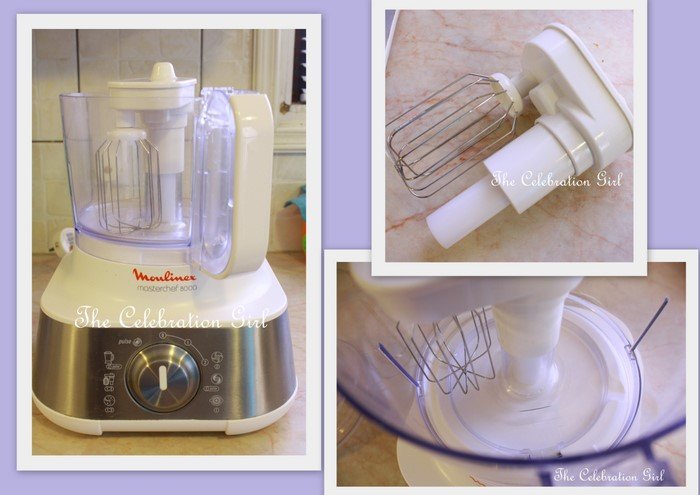
This type of machines have their limitations, and they are generally unable to reach really hard meringue peaks, or they leave a part of the batter unmixed (the one between the bottom of the bowl and the whisk). But they are still very useful (and definitelly better than beating by hand!).
What I will show you is the consistencies I worked with for making these meringue cookies. I am doing this because I know how frustrating it can be to watch pictures of preparations done with stand mixers, not being able to achieve such consistencies and not knowing whether the ones we can actually achieve are enough for the recipe.
The recipe mentions 3 different consistencies:
1) Foamy: When your egg whites look as below, add cream of tartar and salt.

2) Soft peaks: When your egg whites look as below, start adding sugar:

3) Hard peaks: Continue beating until your meringue looks at least as in the picture below.The meringue has to be the harder consistency you can reach in order for the cookies to hold their shape (especially if you want a cute star shape), otherwise they won’t.

This is not the ideal consistency (which is harder) but is all my processor will achieve (after a good 15/20 minutes of beating at maximum speed) and enough to make these cookies. In order to make sure that they do hold their shape, it is a good idea to keep the meringue in the fridge (in a bowl covered with foil) for about 15 minutes, before putting it in the piping bag.
After your meringue is ready, just add colouring and put it into piping bags. For the cookies I made, I used a 2D and a 1M piping tip, for the aqua and lavender cookies, respectively. As you can see from the picture below, the 2D is a closed star tip and the 1M an open star tip. The cookies I piped with the 2D tip held their shape better than the ones I piped with the 1M tip.
Here is how the tips look from above, in case piping tips are classified in a different way where you live:
After you have piped all cookies, simply put them in the oven, following the recipe’s instructions. After they are ready, let them rest in the oven for several hours.
Here is a picture of my aqua cookies the day after I made them:
And this is all! They are cheap, easy to make, delicious to eat and look really pretty at a dessert table! Thank you Susie and Kim for sharing this recipe!
Will you make them?
* Kitchen Aid stand mixers are very expensive outside of the US (560 euros in Cyprus for example)

